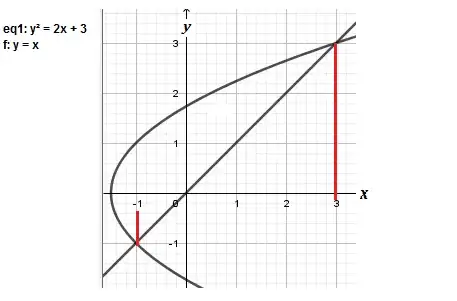In real analysis, the answer is definitely no. Square roots must be nonnegative. They must be additively inverted (meaning they take a negative sign) to access the negative root, so in this case $x=-1$ would solve $x=-\sqrt{2x+3}$ instead of $x=\sqrt{2x+3}$.
This answer explores the possibilities offered by other domains.
Complex analysis
In the complex domain the square root function has two branches that connect continuously to each other rather than directly back to the same branch, as if you were riding a Möbius strip. You could indeed find a negative root with a properly defined branch of the function.
However, we typically define a principal branch such that the real part of the square root is always nonnegative and, where that is zero, the imaginary part is chosen to be nonnegative. This precludes reaching $x=-1$ in the original equation,or roots involving negative "square roots" of real numbers generally, unless we depart from the standard definition even in the complex domain.
$p$-adics
This case is a little more interesting. Consider the familiar Maclaurin series
$\sqrt{1+x}=1+\frac12x-\frac18x^2+...$
which, in real analysis, properly gives a nonnegative value whenever the sum converges ($|x|<1$). We can carry this over into $p$-adics and, where the series converges,we may define a principal square root as the sum thereby chosen. Where the radicand $1+x$ is a rational square, this sum could indeed correspond to what would be the negative root in real analysis. For instance, in $2$-adics the square root of $9=1+8$ obtained from the series is $-3$.
In the problem at hand we ask whether $-1$ can be obtained as a square root in this way. That answer is no; the series for $\sqrt{1+0}$ always converges trivially to $+1$. In $2$-adics where the Maclaurin series converges, we still find that only $x=3$ matches with the sum of the series when checked against $x=\sqrt{2x+3}$.
But other negative integer roots could potentially be obtained. Suppose we were to consider instead the equation
$x=\sqrt{2x+8}$
whose apparent roots, after squaring and solving the resulting quadratic equation, are $-2$ and $4$. The radicand is respectively $4$ and $16$ for these candidates. In real analysis only $x=4$ passes muster. But if instead we choose the $3$-adic domain, then both $4-1=3$ and $16-1=15$ have a terminal zero which is sufficient for the Maclaurin series for $\sqrt{1+x}$ to converge. We may then check $x=-2$ and $x=4$ against the $3$-adic sum of the Maclaurin series, and now we find that they both match: $\sqrt{1+3}$ converges to $-2$ and $\sqrt{1+15}$ converges to $+4$. Thus in $3$-adics, unlike in the reals, both $x=-2$ and $x=4$ may be deemed solutions of $x=\sqrt{2x+8}$ with the Maclaurin-series based square roots.
